engine VOLVO XC90 T8 2017 Owner´s Manual
[x] Cancel search | Manufacturer: VOLVO, Model Year: 2017, Model line: XC90 T8, Model: VOLVO XC90 T8 2017Pages: 580, PDF Size: 10.37 MB
Page 4 of 580
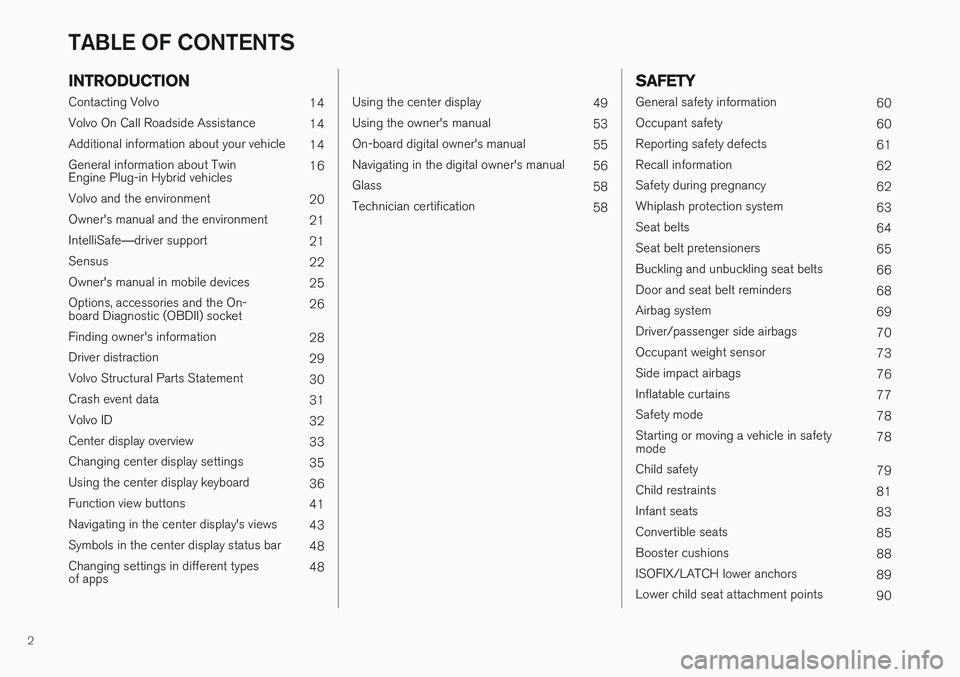
2
INTRODUCTION
Contacting Volvo14
Volvo On Call Roadside Assistance 14
Additional information about your vehicle 14
General information about Twin Engine Plug-in Hybrid vehicles 16
Volvo and the environment 20
Owner's manual and the environment 21
IntelliSafe —driver support
21
Sensus 22
Owner's manual in mobile devices 25
Options, accessories and the On-board Diagnostic (OBDII) socket 26
Finding owner's information 28
Driver distraction 29
Volvo Structural Parts Statement 30
Crash event data 31
Volvo ID 32
Center display overview 33
Changing center display settings 35
Using the center display keyboard 36
Function view buttons 41
Navigating in the center display's views 43
Symbols in the center display status bar 48
Changing settings in different typesof apps 48
Using the center display
49
Using the owner's manual 53
On-board digital owner's manual 55
Navigating in the digital owner's manual 56
Glass 58
Technician certification 58
SAFETY
General safety information60
Occupant safety 60
Reporting safety defects 61
Recall information 62
Safety during pregnancy 62
Whiplash protection system 63
Seat belts 64
Seat belt pretensioners 65
Buckling and unbuckling seat belts 66
Door and seat belt reminders 68
Airbag system 69
Driver/passenger side airbags 70
Occupant weight sensor 73
Side impact airbags 76
Inflatable curtains 77
Safety mode 78
Starting or moving a vehicle in safety mode 78
Child safety 79
Child restraints 81
Infant seats 83
Convertible seats 85
Booster cushions 88
ISOFIX/LATCH lower anchors 89
Lower child seat attachment points 90
TABLE OF CONTENTS
Page 10 of 580
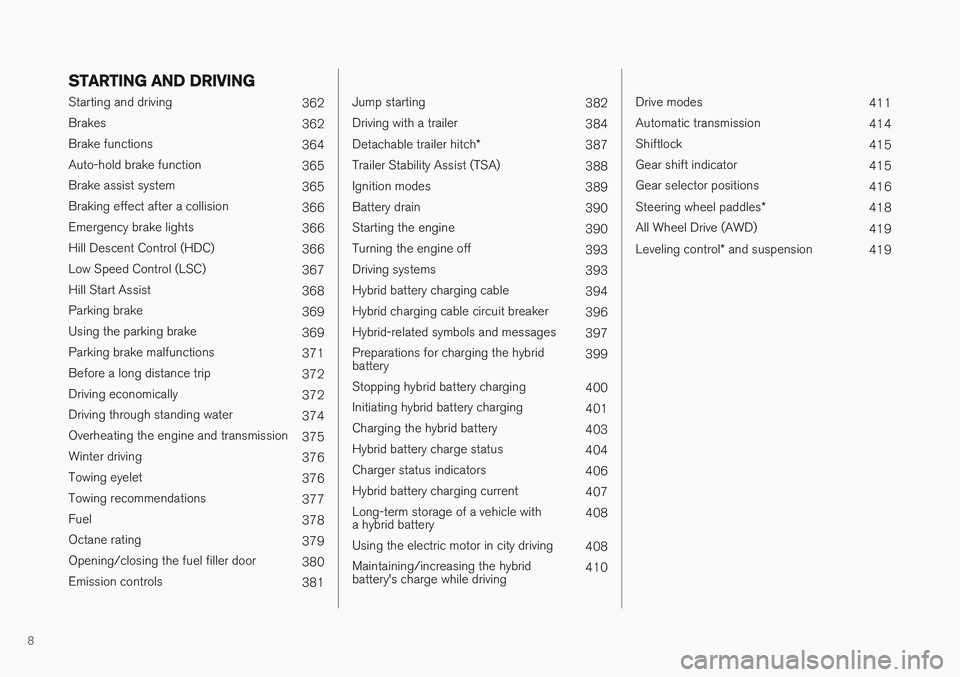
8
STARTING AND DRIVING
Starting and driving362
Brakes 362
Brake functions 364
Auto-hold brake function 365
Brake assist system 365
Braking effect after a collision 366
Emergency brake lights 366
Hill Descent Control (HDC) 366
Low Speed Control (LSC) 367
Hill Start Assist 368
Parking brake 369
Using the parking brake 369
Parking brake malfunctions 371
Before a long distance trip 372
Driving economically 372
Driving through standing water 374
Overheating the engine and transmission 375
Winter driving 376
Towing eyelet 376
Towing recommendations 377
Fuel 378
Octane rating 379
Opening/closing the fuel filler door 380
Emission controls 381
Jump starting382
Driving with a trailer 384
Detachable trailer hitch *
387
Trailer Stability Assist (TSA) 388
Ignition modes 389
Battery drain 390
Starting the engine 390
Turning the engine off 393
Driving systems 393
Hybrid battery charging cable 394
Hybrid charging cable circuit breaker 396
Hybrid-related symbols and messages 397
Preparations for charging the hybrid battery 399
Stopping hybrid battery charging 400
Initiating hybrid battery charging 401
Charging the hybrid battery 403
Hybrid battery charge status 404
Charger status indicators 406
Hybrid battery charging current 407
Long-term storage of a vehicle witha hybrid battery 408
Using the electric motor in city driving 408
Maintaining/increasing the hybridbattery's charge while driving 410
Drive modes
411
Automatic transmission 414
Shiftlock 415
Gear shift indicator 415
Gear selector positions 416
Steering wheel paddles *
418
All Wheel Drive (AWD) 419
Leveling control * and suspension
419
Page 12 of 580
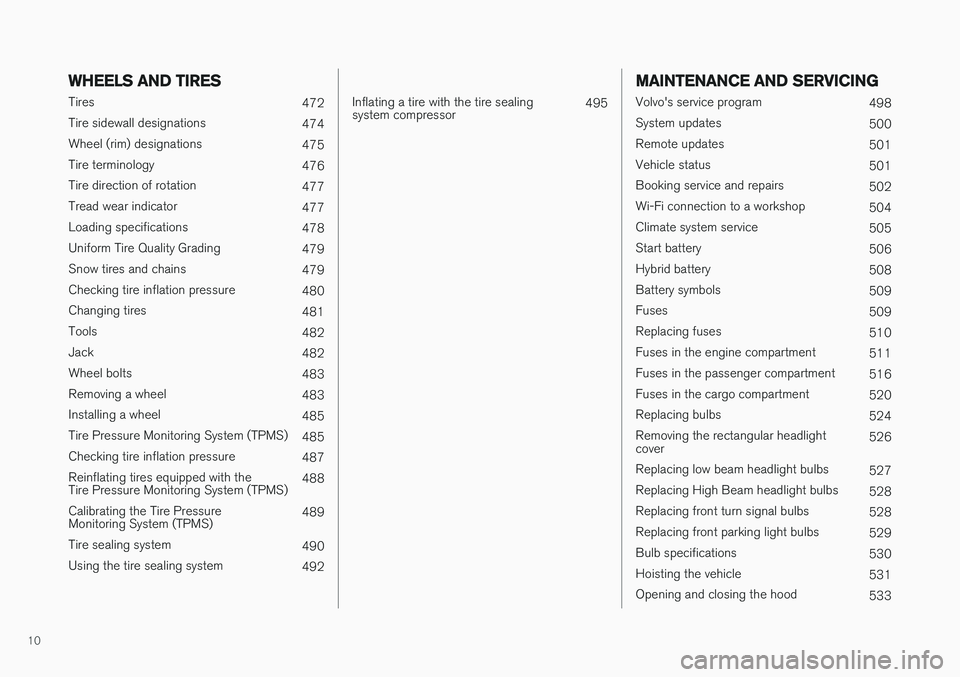
10
WHEELS AND TIRES
Tires472
Tire sidewall designations 474
Wheel (rim) designations 475
Tire terminology 476
Tire direction of rotation 477
Tread wear indicator 477
Loading specifications 478
Uniform Tire Quality Grading 479
Snow tires and chains 479
Checking tire inflation pressure 480
Changing tires 481
Tools 482
Jack 482
Wheel bolts 483
Removing a wheel 483
Installing a wheel 485
Tire Pressure Monitoring System (TPMS) 485
Checking tire inflation pressure 487
Reinflating tires equipped with the Tire Pressure Monitoring System (TPMS) 488
Calibrating the Tire PressureMonitoring System (TPMS) 489
Tire sealing system 490
Using the tire sealing system 492
Inflating a tire with the tire sealing system compressor495
MAINTENANCE AND SERVICING
Volvo's service program
498
System updates 500
Remote updates 501
Vehicle status 501
Booking service and repairs 502
Wi-Fi connection to a workshop 504
Climate system service 505
Start battery 506
Hybrid battery 508
Battery symbols 509
Fuses 509
Replacing fuses 510
Fuses in the engine compartment 511
Fuses in the passenger compartment 516
Fuses in the cargo compartment 520
Replacing bulbs 524
Removing the rectangular headlight cover 526
Replacing low beam headlight bulbs 527
Replacing High Beam headlight bulbs 528
Replacing front turn signal bulbs 528
Replacing front parking light bulbs 529
Bulb specifications 530
Hoisting the vehicle 531
Opening and closing the hood 533
Page 13 of 580
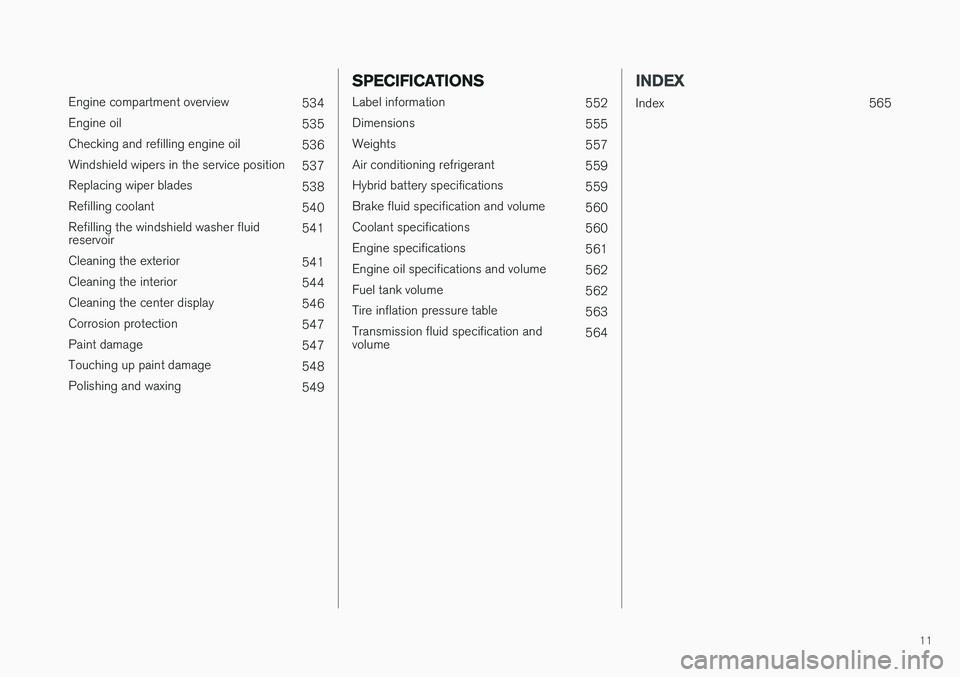
11
Engine compartment overview534
Engine oil 535
Checking and refilling engine oil 536
Windshield wipers in the service position 537
Replacing wiper blades 538
Refilling coolant 540
Refilling the windshield washer fluid reservoir 541
Cleaning the exterior 541
Cleaning the interior 544
Cleaning the center display 546
Corrosion protection 547
Paint damage 547
Touching up paint damage 548
Polishing and waxing 549
SPECIFICATIONS
Label information552
Dimensions 555
Weights 557
Air conditioning refrigerant 559
Hybrid battery specifications 559
Brake fluid specification and volume 560
Coolant specifications 560
Engine specifications 561
Engine oil specifications and volume 562
Fuel tank volume 562
Tire inflation pressure table 563
Transmission fluid specification and volume 564
INDEX
Index 565
Page 18 of 580
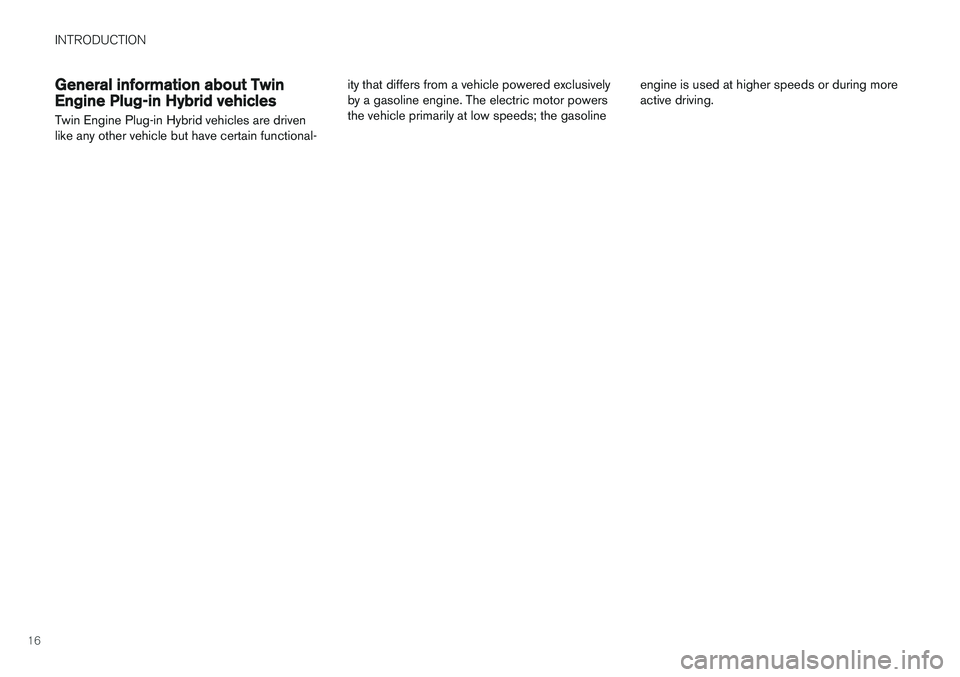
INTRODUCTION
16
General information about Twin Engine Plug-in Hybrid vehicles
Twin Engine Plug-in Hybrid vehicles are driven like any other vehicle but have certain functional- ity that differs from a vehicle powered exclusivelyby a gasoline engine. The electric motor powersthe vehicle primarily at low speeds; the gasoline
engine is used at higher speeds or during moreactive driving.
Page 20 of 580
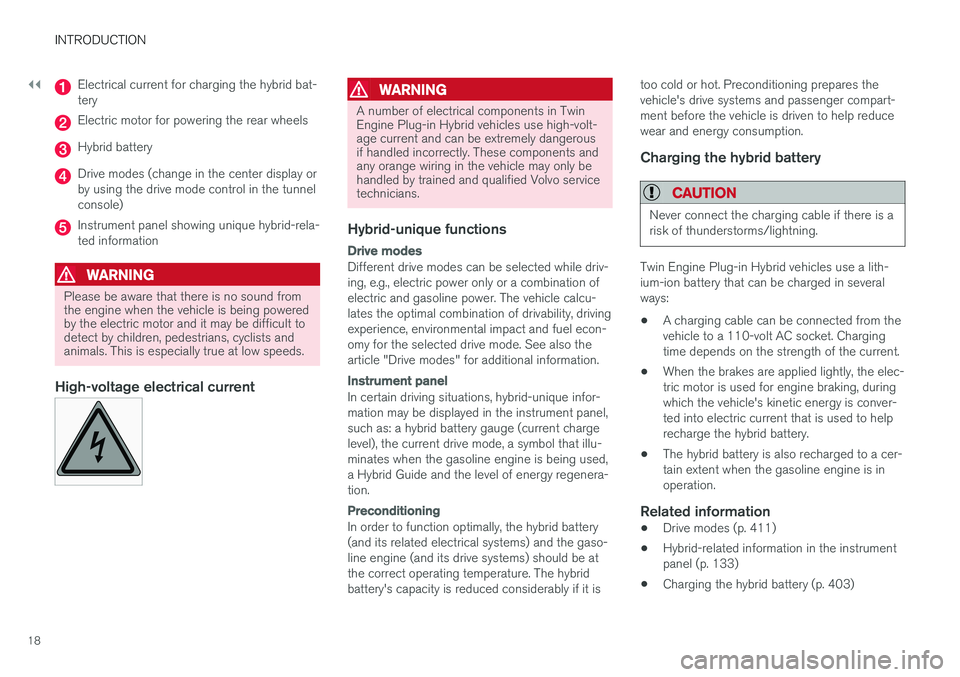
||
INTRODUCTION
18
Electrical current for charging the hybrid bat- tery
Electric motor for powering the rear wheels
Hybrid battery
Drive modes (change in the center display or by using the drive mode control in the tunnelconsole)
Instrument panel showing unique hybrid-rela- ted information
WARNING
Please be aware that there is no sound from the engine when the vehicle is being poweredby the electric motor and it may be difficult todetect by children, pedestrians, cyclists andanimals. This is especially true at low speeds.
High-voltage electrical current
WARNING
A number of electrical components in Twin Engine Plug-in Hybrid vehicles use high-volt-age current and can be extremely dangerousif handled incorrectly. These components andany orange wiring in the vehicle may only behandled by trained and qualified Volvo servicetechnicians.
Hybrid-unique functions
Drive modes
Different drive modes can be selected while driv- ing, e.g., electric power only or a combination ofelectric and gasoline power. The vehicle calcu-lates the optimal combination of drivability, drivingexperience, environmental impact and fuel econ-omy for the selected drive mode. See also thearticle "Drive modes" for additional information.
Instrument panel
In certain driving situations, hybrid-unique infor- mation may be displayed in the instrument panel,such as: a hybrid battery gauge (current chargelevel), the current drive mode, a symbol that illu-minates when the gasoline engine is being used,a Hybrid Guide and the level of energy regenera-tion.
Preconditioning
In order to function optimally, the hybrid battery (and its related electrical systems) and the gaso-line engine (and its drive systems) should be atthe correct operating temperature. The hybridbattery's capacity is reduced considerably if it istoo cold or hot. Preconditioning prepares thevehicle's drive systems and passenger compart-ment before the vehicle is driven to help reducewear and energy consumption.
Charging the hybrid battery
CAUTION
Never connect the charging cable if there is a risk of thunderstorms/lightning.
Twin Engine Plug-in Hybrid vehicles use a lith- ium-ion battery that can be charged in severalways:
• A charging cable can be connected from thevehicle to a 110-volt AC socket. Chargingtime depends on the strength of the current.
• When the brakes are applied lightly, the elec-tric motor is used for engine braking, duringwhich the vehicle's kinetic energy is conver-ted into electric current that is used to helprecharge the hybrid battery.
• The hybrid battery is also recharged to a cer-tain extent when the gasoline engine is inoperation.
Related information
•
Drive modes (p. 411)
• Hybrid-related information in the instrumentpanel (p. 133)
• Charging the hybrid battery (p. 403)
Page 21 of 580
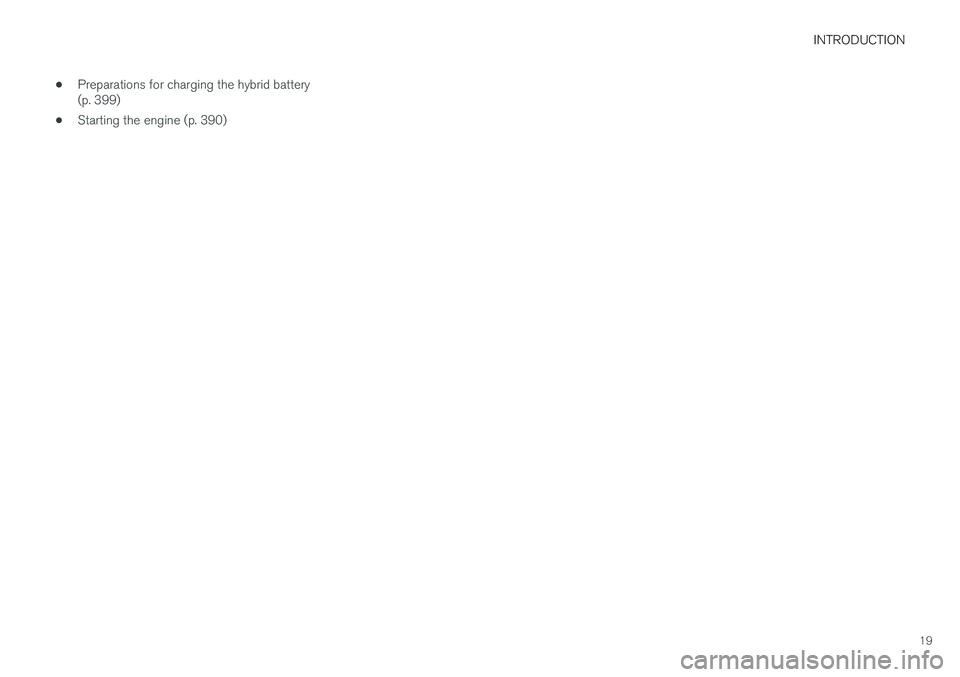
INTRODUCTION
19
•
Preparations for charging the hybrid battery (p. 399)
• Starting the engine (p. 390)
Page 22 of 580
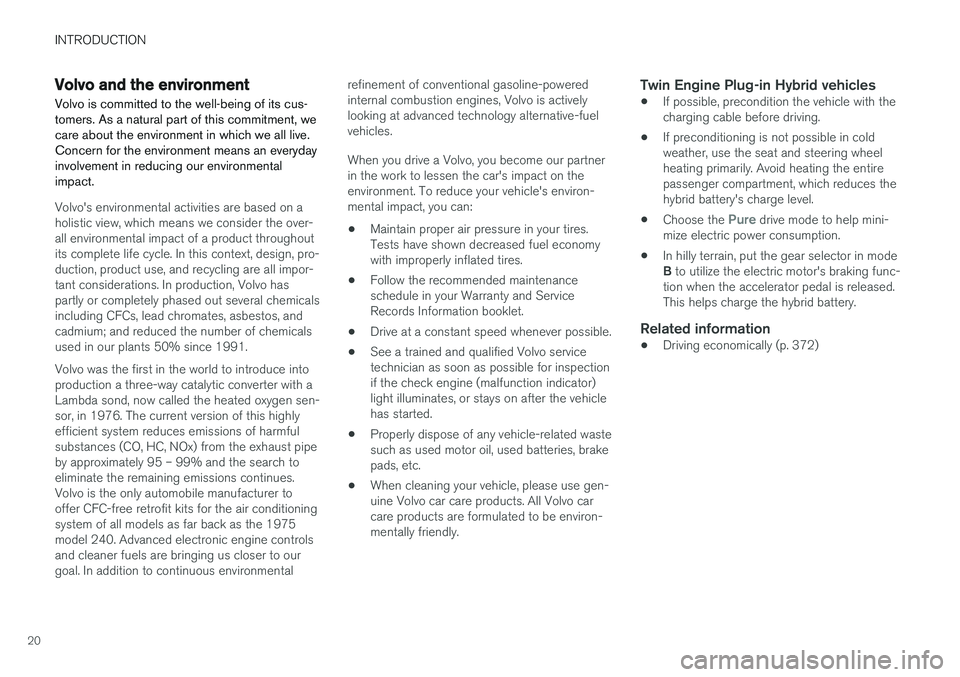
INTRODUCTION
20
Volvo and the environment Volvo is committed to the well-being of its cus- tomers. As a natural part of this commitment, wecare about the environment in which we all live.Concern for the environment means an everydayinvolvement in reducing our environmentalimpact.
Volvo's environmental activities are based on a holistic view, which means we consider the over-all environmental impact of a product throughoutits complete life cycle. In this context, design, pro-duction, product use, and recycling are all impor-tant considerations. In production, Volvo haspartly or completely phased out several chemicalsincluding CFCs, lead chromates, asbestos, andcadmium; and reduced the number of chemicalsused in our plants 50% since 1991. Volvo was the first in the world to introduce into production a three-way catalytic converter with aLambda sond, now called the heated oxygen sen-sor, in 1976. The current version of this highlyefficient system reduces emissions of harmfulsubstances (CO, HC, NOx) from the exhaust pipeby approximately 95 – 99% and the search toeliminate the remaining emissions continues.Volvo is the only automobile manufacturer tooffer CFC-free retrofit kits for the air conditioningsystem of all models as far back as the 1975model 240. Advanced electronic engine controlsand cleaner fuels are bringing us closer to ourgoal. In addition to continuous environmentalrefinement of conventional gasoline-poweredinternal combustion engines, Volvo is activelylooking at advanced technology alternative-fuelvehicles. When you drive a Volvo, you become our partner in the work to lessen the car's impact on theenvironment. To reduce your vehicle's environ-mental impact, you can:
• Maintain proper air pressure in your tires.Tests have shown decreased fuel economywith improperly inflated tires.
• Follow the recommended maintenanceschedule in your Warranty and ServiceRecords Information booklet.
• Drive at a constant speed whenever possible.
• See a trained and qualified Volvo servicetechnician as soon as possible for inspectionif the check engine (malfunction indicator)light illuminates, or stays on after the vehiclehas started.
• Properly dispose of any vehicle-related wastesuch as used motor oil, used batteries, brakepads, etc.
• When cleaning your vehicle, please use gen-uine Volvo car care products. All Volvo carcare products are formulated to be environ-mentally friendly.
Twin Engine Plug-in Hybrid vehicles
• If possible, precondition the vehicle with thecharging cable before driving.
• If preconditioning is not possible in coldweather, use the seat and steering wheelheating primarily. Avoid heating the entirepassenger compartment, which reduces thehybrid battery's charge level.
• Choose the
Pure drive mode to help mini-
mize electric power consumption.
• In hilly terrain, put the gear selector in mode B
to utilize the electric motor's braking func-
tion when the accelerator pedal is released. This helps charge the hybrid battery.
Related information
• Driving economically (p. 372)
Page 28 of 580

INTRODUCTION
26
Options, accessories and the On- board Diagnostic (OBDII) socket We strongly recommend that Volvo owners install only genuine, Volvo-approved accesso-ries, and that accessory installations be per-formed only by a trained and qualified Volvoservice technician.
Optional or accessory equipment described in this manual is indicated by an asterisk. Optional or accessory equipment may not be available in all countries or markets. Please notethat some vehicles may be equipped differently,depending on special legal requirements. Contact your Volvo retailer for additional informa- tion.
NOTE
• Do not export your Volvo to another country before investigating that coun-try's applicable safety and exhaust emis-sion requirements. In some cases it maybe difficult or impossible to comply withthese requirements. Modifications to theemission control system(s) may renderyour Volvo not certifiable for legal opera-tion in the U.S., Canada and other coun-tries.
• All information, illustrations and specifica-tions contained in this manual are basedon the latest product information availa-ble at the time of publication. Please notethat some vehicles may be equipped dif-ferently, depending on market-specificadaptations or special legal requirements.Optional equipment described in thismanual may not be available in all mar-kets.
• Some of the illustrations shown aregeneric and are intended as examplesonly, and may not depict the exact modelfor which this owner's information isintended.
• Volvo reserves the right to make modeland product changes at any time, or tochange specifications or design withoutnotice and without incurring obligation.
WARNING
If your vehicle is involved in an accident, unseen damage may affect its drivability andsafety.
WARNING
CALIFORNIA proposition 65 Engine exhaust, some of its constituents, and certain vehicle components contain or emitchemicals known to the state of California tocause cancer, and birth defects or otherreproductive harm. In addition, certain fluidscontained in vehicles and certain products ofcomponent wear contain or emit chemicalsknown to the State of California to cause can-cer, and birth defects or other reproductiveharm.
WARNING
Certain components of this vehicle such as air bag modules, seat belt pretensioners, adap-tive steering columns, and button cell batter-ies may contain Perchlorate material. Specialhandling may apply for service or vehicle endof life disposal. See www.dtsc.ca.gov/hazardouswaste/ perchlorate.
• Genuine Volvo accessories are tested to ensure compatibility with the performance,safety, and emission systems in your vehicle.
Page 32 of 580

||
INTRODUCTION
30and qualified Volvo service technician before installing any accessory in or on your vehicle.
• Accessories that have not been approved byVolvo may or may not be specifically testedfor compatibility with your vehicle. Addition-ally, an inexperienced installer may not befamiliar with some of your car's systems.
• Any of your car's performance and safetysystems could be adversely affected if youinstall accessories that Volvo has not tested,or if you allow accessories to be installed bysomeone unfamiliar with your vehicle.
• Damage caused by unapproved or improperlyinstalled accessories may not be covered byyour new vehicle warranty. See your Warrantyand Service Records Information booklet formore warranty information. Volvo assumes noresponsibility for death, injury, or expensesthat may result from the installation of non-genuine accessories.
WARNING
The driver is always responsible for operating the vehicle in a safe manner and for comply-ing with current statutes and regulations. It is also essential to maintain and service the vehicle according to Volvo's recommendationsas stated in the owner's information and theservice and warranty booklet. If the on-board information differs from the printed owner's manual, the printed informa-tion always takes precedence.
Related information
•
Volvo Structural Parts Statement (p. 30)
Volvo Structural Parts Statement
Volvo has always been and continues to be a leader in automotive safety.
Volvo engineers and manufactures vehicles designed to help protect vehicle occupants in theevent of a collision. Volvos are designed to absorb the impact of a collision. This energy absorption system including,but not limited to, structural components such asbumper reinforcement bars, bumper energyabsorbers, frames, rails, fender aprons, A-pillars,B-pillars and body panels must work together tomaintain cabin integrity and protect the vehicleoccupants. The supplemental restraint system including but not limited to air bags, side curtain air bags, anddeployment sensors work together with theabove components to provide proper timing forair bag deployment. Due to the above, Volvo Car USA does not sup- port the use of aftermarket, alternative or any-thing other than original Volvo parts for collisionrepair. Volvo Car USA also recommends using Volvo- approved replacement glass. The use of after-market glass, particularly a windshield, can havean adverse effect on collision avoidance andadvanced lighting systems. In addition Volvo does not support the use or re- use of structural components from an existing